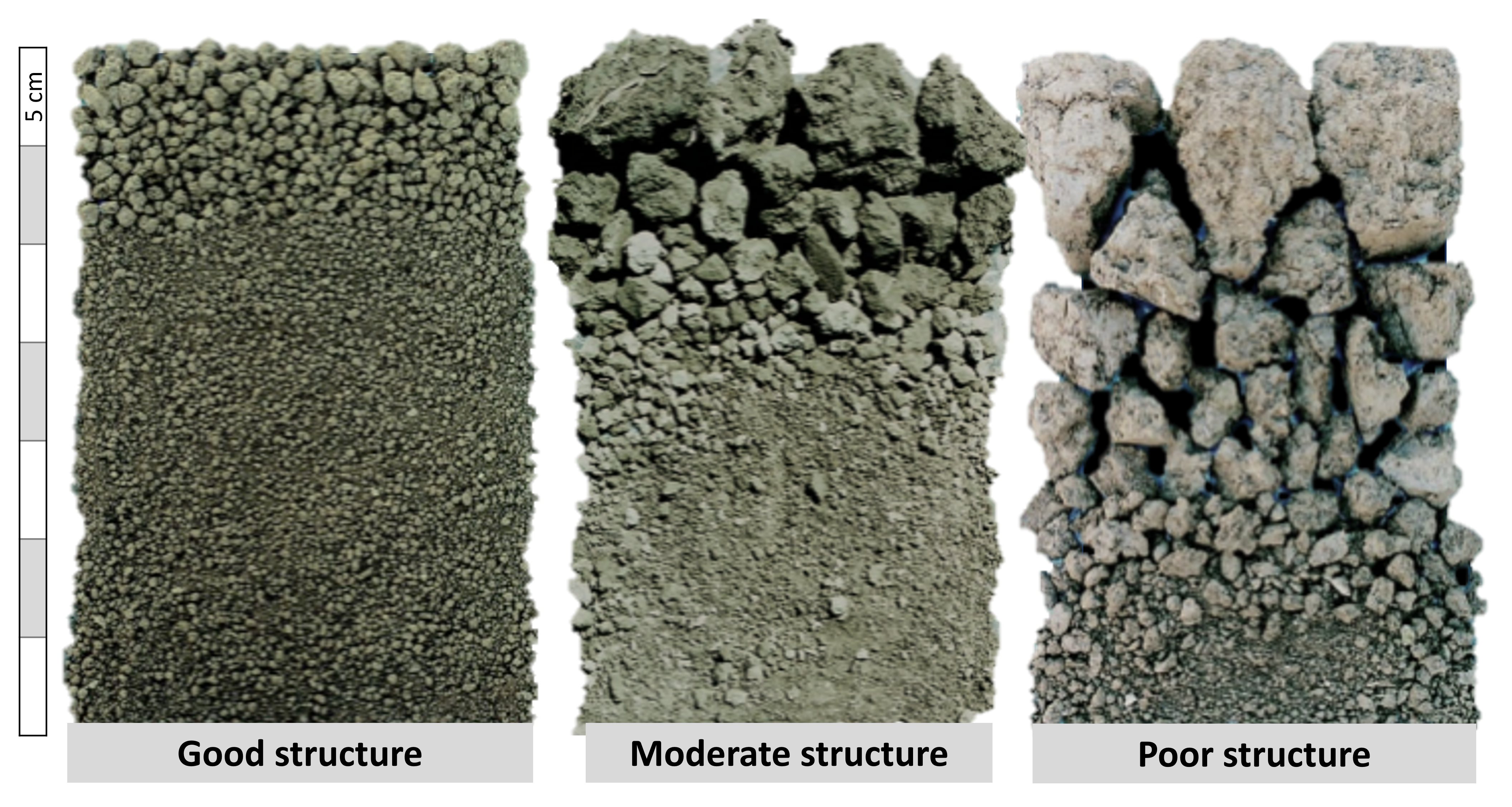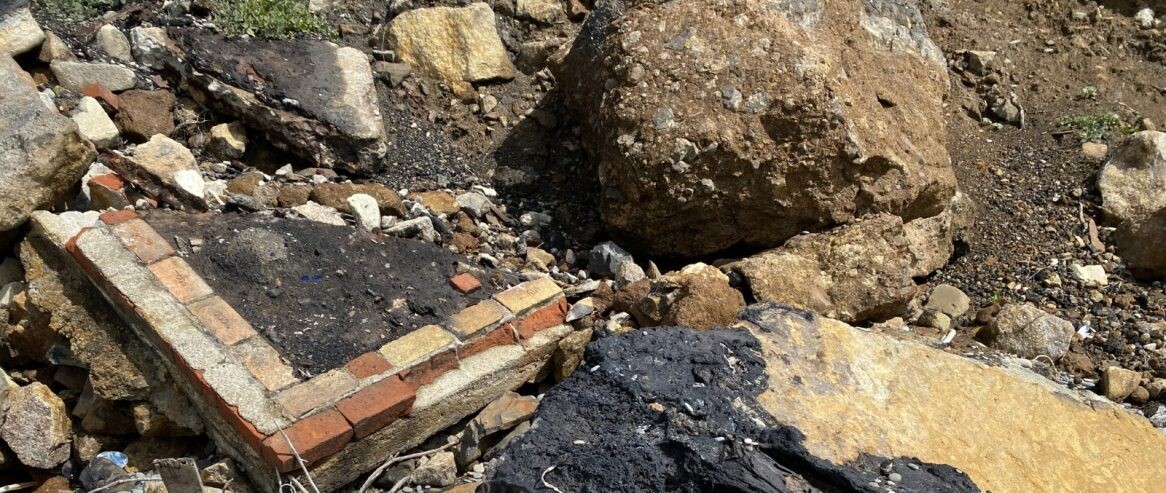Soil is valuable for landowners, and there are ways you can enhance and protect it.
Some soil properties, such as texture, are stable and don’t change easily with land use or management. Others can be maintained or enhanced to keep our soils healthy and productive for today and future generations.
An essential ingredient of soil is organic matter, which is made up of plants and animals at different stages of decomposition [1]. Organic matter provides energy for the immense diversity of soil organisms that perform important processes in the soil. It is also a critical nutrient source for plants. In other words, it is very much at the heart of soil health. We monitor levels of organic matter in Otago’s soils as part of the Soil Health Monitoring Programme

Although organic matter typically makes up only a small proportion of mineral soil (around 10%), it positively influences the physics, chemistry and biology of soil [2], including:
- Improved structure
Organic matter increases the stability of soil aggregates, infiltration of water and soil aeration, which makes soil more resilient to compaction and erosion. - Enhanced fertility
Organic matter increases the pH buffering capacity, cation exchange capacity (the ability to store and supply certain nutrients) and mineral nutrient availability via weathering. - Increased biological activity
Organic matter promotes the activity of beneficial microbes. This helps to suppress diseases and enhances burrowing, which naturally mixes soil, improving its structure.
Increasing or maintaining the levels of organic matter levels in your soil is crucial for farm and environmental sustainability. While other factors influence how much organic matter can be built up, you can raise levels by adding more organic matter and reducing the amount you lose [3]:
Increase inputs
- You can add organic amendments (manure, effluent, plant residues, compost, mulch), which are converted into soil organic matter over time.
- You can use cover crops to maintain soil cover and build organic matter from the root mass. Legume cover crops add nitrogen, which helps to decompose freshly added organic materials.
Reduce losses
- Using conservation tillage practices avoids exposing soil organic matter to the air, which increases its loss via erosion and rapid decomposition.
- You can keep a cover of vegetation or mulch over bare soil to protect soil from erosion which removes topsoil containing soil organic matter.
The structure of soil is a key component in how it functions, affecting agricultural sustainability and environmental quality [5]. Structure is determined by the size, shape and arrangement of solids (inorganic and organic matter) and voids (pore spaces) in the soil – a bit like a sponge. This influences how water, air, roots and other substances can move through the soil. Good soil structure can increase your crop yield [6] and makes the soil more resilient to compaction and erosion.

A good soil structure has small and stable aggregates [7]. Aggregates are formed when organic and inorganic particles are bound together into larger compounds of different sizes. The strength of the bonds varies depending on their ingredients. The structure of soil in Otago also varies naturally depending on how it was formed and what it was formed from.
Smaller aggregates allow plenty of space for water, gas and roots to move freely through the soil, providing easier access to nutrients. Stable aggregates resist wind, water, tillage and compaction. In degraded soil structures, the aggregates form large clods that are hard to break when dry but disperse easily when wet. Risks of degraded soil structure are surface capping, excessive wetness, drought and loss of soil to wind and water erosion [5]. Soil structure can be degraded when organic matter is lost or the soil is compacted by over-working or over-grazing the land. We monitor soil structure indicators in Otago through the Soil Health Monitoring Programme.

Soil in Otago
Otago’s diverse landscapes, geology and climates have formed a variety of soils; from coastal volcanic based soils and semiarid soils to acidic podzols and carbon-rich organic soils. Learn more about our soils, where they can be found and how they behave.

Soil health monitoring
We monitor soil from a range of sites across the region as part of the national soil health monitoring programme. This is designed as an early warning system to aid in the preservation of this valuable resource. Learn more about why we do it and what we measure.

Soil and land data
Soil microclimate stations across the region collect data on soil moisture, soil temperature and rainfall to support land management and modelling. Learn why we collect this information, what it means and how to explore the data.
Improve structure [6]
- You can use minimum and no-tillage methods, which are not as disruptive as conventional tillage.
- You can improve the stability of soil aggregates by increasing the soil’s organic matter content and reducing its loss.
Prevent compaction [5]
- You can prevent compaction by reducing the weight of equipment, the number of farming vehicle operations and/or distributing the load over a greater surface area (wider tires, for example).
- It is best to avoid putting heavy vehicle or grazing loads on soil that is wet (above field capacity).
Prevent erosion
- The best way to prevent erosion is to keep soil cover as constant as possible.
- You can make soil more resilient to erosion by improving its structure and preventing compaction.
Contaminated soil threatens environmental and human health. It can also threaten food security as productive land may be lost indefinitely. While it is sometimes possible to remediate contaminated land, it can take significant time and money. You can find information about contaminated land under Waste and Hazardous Substances, but it is critical to make sure soil does not become contaminated in the first place.

Ninety-three percent of the Earth’s mass is made up of only four elements (iron, oxygen, silicon and magnesium). The rest are present at concentrations less than 2%, with most at concentrations less than 0.1%. These trace elements occur naturally but can become toxic to the environment and humans at elevated levels [8].
The table shows common sources of potentially toxic elements in primary industries. We monitor levels of these elements in Otago through the Soil Health Monitoring Programme.
| Potentially toxic elements | Sources in Aotearoa New Zealand | |
| Arsenic | As | Wood preservatives and alloys |
| Cadmium | Cd | Phosphorus-based fertiliser, alloys, batteries |
| Chromium | Ch | Wood preservatives, pesticides, alloys, dyes |
| Copper | Cu | Copper-based fungicides and pesticides, wood preservatives, paints |
| Lead | Pb | Lead-based paints and petrol, batteries, metal products |
| Nickel | Ni | Alloys and batteries |
| Zinc | Zn | Wood preservatives, livestock eczema ointments, car tyre threads, alloys, paints |
Cadmium
Higher levels of cadmium are typically linked to phosphate (P) fertilisers because the primary sources of these fertilisers in Aotearoa New Zealand naturally contain higher levels of the element. Different tiers with soil cadmium concentration trigger values have been devised to manage the accumulation of cadmium in soil [9]. Cadmium levels measured in Otago have predominantly been in Tier 1 (<0.6 mg Cd/kg soil) with only few in Tier 2 (0.6-1.0 mg Cd/kg soil) [10].
Naturally elevated areas of arsenic
Levels of some potentially toxic elements can be higher than the expected trace levels because of the area’s geology and associated natural processes. Arsenic is predicted to be naturally elevated in 15% of Otago due to geological processes [11]. These modelled areas can be identified using the Trace Element Explorer [12], though they are likely to vary substantially at finer scales.
Otago waste

Contaminated land
Contaminants in soil can cause adverse effects on both human health and the environment through both short-term and long-term exposure. You can find the HAIL (Hazardous Activities and Industries List) database here.

Cleanfill
Cleanfill materials are natural soils such as clay, soil, and rock, and some manufactured materials such as concrete, brick or tiles.

National Predicted Background Concentration (PBC)
The PBC dataset on the LRIS Portal, developed by Manaaki Whenua Landcare Research, has information on concentration levels.
[1] Lehmann, J. and Kleber, M., 2015. The contentious nature of soil organic matter. Nature, 528(7580), 60-68.
[2] Weil, R.R. and Magdoff, F., 2004. Significance of soil organic matter to soil quality and health. Soil organic matter in sustainable agriculture, 1-43.
[3] Magdoff, F. and Weil, R.R., 2004. Soil organic matter management strategies. Soil organic matter in sustainable agriculture, 45-65.
[4] Bronick, C.J. and Lal, R., 2005. Soil structure and management: a review. Geoderma, 124(1-2), 3-22.
[5] Lal, R., 1991. Soil structure and sustainability. Journal of sustainable agriculture, 1(4), 67-92.
[6] Munkholm, L.J., Heck, R.J. and Deen, B., 2013. Long-term rotation and tillage effects on soil structure and crop yield. Soil and Tillage Research, 127, 85-91.
[7] Shepherd, T.G. 2000: Visual Soil Assessment. Volume 1. Field guide for cropping and pastoral grazing on flat to rolling country. horizons.mw & Landcare Research, Palmerston North. 84p. Photo reproduced with permission.
[8] Hooda, P.S. ed., 2010. Trace elements in soils (Vol. 618). Chichester: Wiley.
[9] Fertiliser Association, 2019. Tiered Fertiliser Management System for Soil Cadmium. Cadmium Management Group.
[10] Taylor, M., Gibb, R., Willoughby, J., Hewitt A., Arnold, G., 2007. Soil maps of cadmium in New Zealand. Manaaki Whenua - Landcare Research.
[11] Cavanagh, J., McNeill, S., Roudier, P., Thompson-Morrison, H., Martin, A., Turnbull, R., 2023. Determining background soil concentrations of trace elements across New Zealand. Landcare Research New Zealand Ltd and Hawke’s Bay Regional Council. Envirolink Grant: 2321-HBRC267.
[12] Manaaki Whenua - Landcare Research, 2023. Trace element background concentration explorer. https://lris.scinfo.org.nz/layer/114281-pbc-predicted-background-soil-concentrations-new-zealand-h3-resolution-9/
